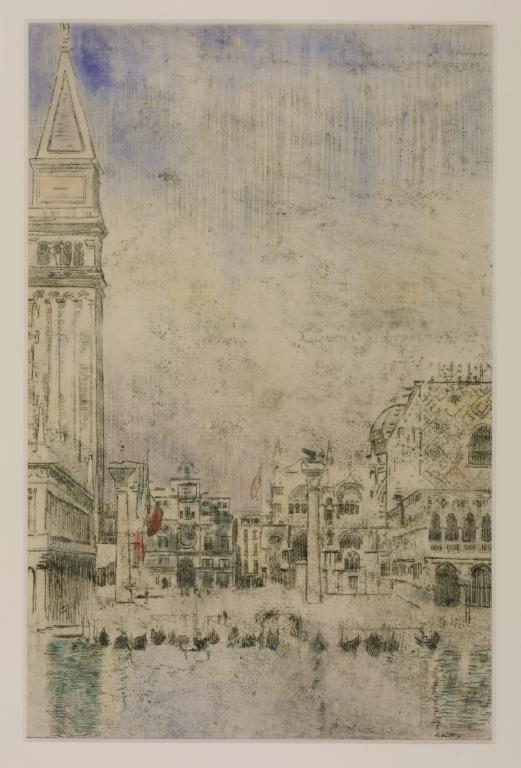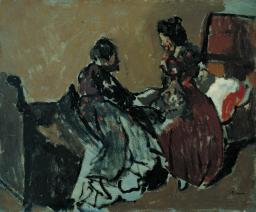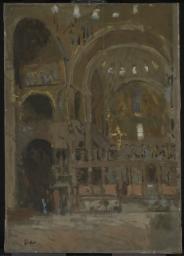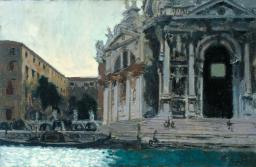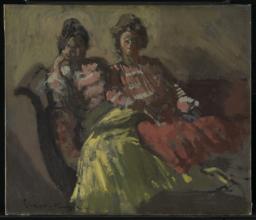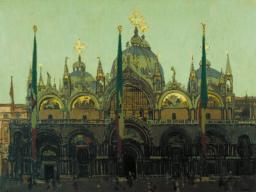Walter Richard Sickert The Piazzetta and the Old Campanile, Venice c.1901
Walter Richard Sickert,
The Piazzetta and the Old Campanile, Venice
c.1901
This rare transfer image by Sickert, traced using typewriter carbon paper, has no known original sketch. Whether Sickert executed the classical view of the Piazzetta from life is uncertain, in which case his vantage point must have been from a boat. However, it is possible that he drew from postcards or guidebooks. Bright blue, peach and yellow pastels emphasise elements of the architecture as well as the sky, over which graphite cross-hatching provides further articulation.
Walter Richard Sickert 1860–1942
The Piazzetta and the Old Campanile, Venice
c.1901
Carbon paper tracing and pastel on paper
544 x 365 mm
Purchased (Duveen Drawings Fund) 1923
N03810
c.1901
Carbon paper tracing and pastel on paper
544 x 365 mm
Purchased (Duveen Drawings Fund) 1923
N03810
Ownership history
... ; Mrs Robert Campbell; her sale Christie’s, London, 8 December 1922 (89, as ‘Venice and the Old Campanile’), bought for 18 guineas by S.C. Cockerill; sold Christie’s, 27 April 1923 (11), bought Rance, and afterwards acquired by Tate Gallery.
Exhibition history
1946
The One Hundred and Twentieth Exhibition of the Royal Scottish Academy of Painting, Sculpture, and Architecture, Royal Scottish Academy, Edinburgh, 1946 (700, as ‘Venice and the Old Campanile’).
1960
Sickert: Paintings and Drawings, (Arts Council tour), Tate Gallery, London, May–June 1960, Southampton Art Gallery, July 1960, Bradford City Art Gallery, July–August 1960 (94).
1989–90
W.R. Sickert: Drawings and Paintings 1890–1942, Tate Gallery, Liverpool, March 1989–February 1990, Tate Gallery, London, July–September 1990 (26, reproduced).
2009
Sickert in Venice, Dulwich Picture Gallery, London, March–May 2009 (1, reproduced).
References
1958
Twentieth century British water-colours from the Tate Gallery and the Victoria & Albert Museum, exhibition catalogue, Victoria and Albert Museum, London 1958, reproduced pl.10.
1960
Lillian Browse, Sickert, London 1960, p.103.
1964
Mary Chamot, Dennis Farr and Martin Butlin, Tate Gallery Catalogues: The Modern British Paintings, Drawings and Sculpture, vol.2, London 1964, p.623.
2006
Wendy Baron, Sickert: Paintings and Drawings, New Haven and London 2006, no.157.4.
Technique and condition
The Piazzetta and the Old Campanile, Venice is a carbon paper tracing with pastel on laid paper. The technique and execution of this work are similar to the other two Tate works on paper executed in Dieppe by Walter Sickert (Tate N05094 and N05096). The paper is light weight and off-white in tone and the drawing has a grainy quality, particularly in the sky and lagoon area, suggestive of a transfer technique. The drawing covers almost the full extent of this rectangular paper sheet, but the edges of the carbon paper, used to transfer the compositional elements from a previous sketch or sketches, are just visible along the edges, forming a black rectangle.
After the carbon tracing, peach, blue, green, red and purple pastels were applied to colour and emphasise certain elements of the image, including the architecture, sky and lagoon. Cross-hatching was applied on top of the pastel in a black graphic medium, possibly using the carbon paper or working directly onto the paper pencil, to suggest depth in the sky and certain architectural features. Although this work has a sketch-like quality, the lines are not loose but very controlled and the architectural features are carefully proportioned, reflecting Sickert’s planning process.
Kate Jennings
June 2005
How to cite
Kate Jennings, 'Technique and Condition', June 2005, in Robert Upstone, ‘The Piazzetta and the Old Campanile, Venice c.1901 by Walter Richard Sickert’, catalogue entry, May 2009, in Helena Bonett, Ysanne Holt, Jennifer Mundy (eds.), The Camden Town Group in Context, Tate Research Publication, May 2012, https://wwwEntry
Walter Sickert made this transfer image using typewriter carbon paper and finished it with pastel. Whether he was investigating some form of producing multiples is unknown, but it is an intriguing possibility. However, no similar carbon drawing of The Piazzetta and the Old Campanile, Venice is known, or the original. Being able to manufacture several drawings simultaneously would save considerable time, and hand-finishing would make certain their status as original works. It was a way of working that artists had used in the past, albeit not with the new and modern material of carbon paper. In the eighteenth century, for instance, Thomas Rowlandson had combined printing with a form of graphite medium to imitate original drawing, and then hand-coloured the results. Also related, and undoubtedly known to Sickert, was Edgar Degas’s practice of making multiple traced images, applying pastel over the top and nuancing every image, so that each was wholly individual.1
Whether Sickert based the drawing on first-hand sketches is unknown. If it was, then these would have had to have been made from the vantage point of a boat. However, it is such a classic Venetian view that it is possible that Sickert simply drew it from postcards or guidebooks. Sickert certainly used such source material, and in a letter to Mrs Humphrey in 1899 he mentioned how, in London, he used ‘photographs of sitters and photographs of Venice’.2 The relatively large size of The Piazzetta and the Old Campanile, Venice raises the possibility that, in addition to being a carbon copy drawing, it was scaled up using a pantograph, a drawing instrument that can also be used to trace from photographs, for instance. The smudgy areas in the sky suggest that Sickert may have deliberately rubbed the carbon paper to create this effect, giving it texture and shading.
Traditionally, the drawing has been dated to c.1901, when Sickert was in Venice from January to July. However, there is no particular evidence for this. Sickert would return to a subject or motif at almost any time in his life. He made etchings of Venice in c.1902, such as Venice, The Façade of St Mark’s,3 which reproduces his painting St Mark’s, Venice (‘Pax Tibi Marce Evangelista Meus’) of 1896–7 (Tate N05914). But, as late as 1915, he made another group of etchings of the city, including Venice, The Lion of St Mark’s,4 which similarly utilised work he had made twenty years before. The bright colouring of Tate’s drawing would seem to count against such an early dating of 1901. Indeed, the dominant dazzling blue and the slightly fuzzy application seems to have more relation with works from the early 1920s, such as the oil painting Baccarat 1920 (private collection),5 or, equally, it might date from Sickert’s second campaign of Venetian printmaking in 1915.
Sickert made three oil paintings that are closely related to The Piazzetta and the Old Campanile, Venice.6 Essentially they are the same composition but painted under slightly different lighting conditions. One of them, for instance, is a nocturne, Le Palais des Doges au Crépuscule, Venice 1901 (private collection).7 In each oil the architectural drawing and, crucially, its scale are near identical to the Tate drawing. This must indicate some association between the carbon drawing and these oils. It is possible that Sickert used carbon paper to transfer his design in some way onto the canvas itself, and do away with the necessity of squaring up. Another related oil is The Doge’s Palace and the Campanile, Venice 1900 (private collection),8 although here the viewpoint is from slightly further away.
Robert Upstone
May 2009
Notes
See Richard Kendall, ‘Drawing, Tracing and the Sequence’, in Degas: Beyond Impressionism, exhibition catalogue, National Gallery, London 1996, pp.186–8.
Quoted in Wendy Baron and Richard Shone (eds.), Sickert: Paintings, exhibition catalogue, Royal Academy, London 1992 (21).
Related biographies
Related catalogue entries
How to cite
Robert Upstone, ‘The Piazzetta and the Old Campanile, Venice c.1901 by Walter Richard Sickert’, catalogue entry, May 2009, in Helena Bonett, Ysanne Holt, Jennifer Mundy (eds.), The Camden Town Group in Context, Tate Research Publication, May 2012, https://www

